The rate includes per person per night:
- Overnight accommodation
- Breakfast

The rate includes per person per night:
Click the "See calendar and prices" button to choose dates and see the room selection.
See calendar and prices: Standard RateBanegårdspladsen 4, 1570 Copenhagen
Show map
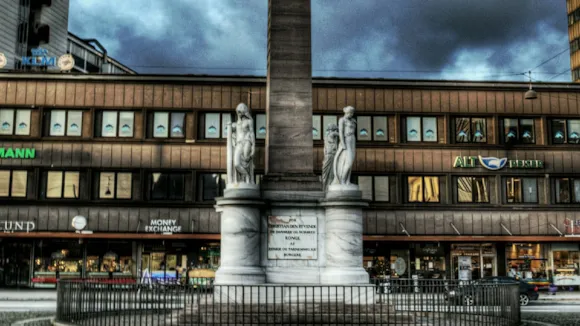
0.13 km
The Liberty Column in Copenhagen is a 20 meter tall Obelisque, erected in memory of the peasant reforms, 20 June 1788. These reforms led to the abolition of the adscription.
The four symbolic female figures on top of the column symbolise Bravery, Civic Virtue, Fidelity and The Industrious Cultivation of Land.
Connection to the construction of Copenhagen Central Station, The Liberty Column was moved a few meters from its original place.
In 1850-51, the monument was renovated for the first time. In 1999, it was unveiled after a huge renovation where the Obelisque and the four statues were replaced by exact copies.

0.21 km
Just a two-minute walk from Copenhagen Central Station, Tivoli Gardens welcomes you into a world of wonder. Founded in 1843, it’s one of the world’s oldest amusement parks and a true Copenhagen icon. But Tivoli is much more than just rides. When you enter the gates, you’ll meet twinkling lights, the sweet scent of the garden flowers and stalls, and the sound of laughter. You can chase the thrills from the many rides, enjoy a peaceful stroll through the beautiful gardens, experience magical live performances like concerts, ballet and theatre, eat great food, and much more. This unique mix of atmosphere, charm, and variety keeps both locals and visitors coming back time and time again.
What makes Tivoli unique?
Tivoli is one of the world’s oldest amusement parks, and its rich history is felt throughout. It blends classic and modern rides with stunning gardens and a wide range of great dining experiences.
Is Tivoli family-friendly?
Absolutely. Tivoli offers gentle rides, playgrounds, seasonal shows, and plenty of family-friendly restaurants.
When is the best time to visit?
Summer evenings for outdoor concerts and dining; October for Halloween decorations; and December for the Christmas market and festive lights. Expect the most visitors on Fridays, Saturdays and Sundays.
Is it possible to get guided tours in Tivoli?
Guided tours are offered during select times of the year, while self-guided audio tours are available year-round. For details, visit the Tivoli website.
Are the rides open every season?
Yes, all the rides are open every season. However, if the weather is very windy or rainy, they will be temporarily closed.
Live performances in Tivoli:
Check Tivoli’s website to see which live performances are happening right now.
Tivoli transforms throughout the year with special decorations, markets, and events:
Tivoli isn’t just an amusement park – it’s part of Copenhagen’s cultural identity. Generations of Danes have grown up here, and millions of international visitors come every year to experience its unique blend of history, thrills, food, and atmosphere. Whether you’re riding the rollercoasters, dining in style, or simply wandering through the gardens, Tivoli promises memories that last a lifetime.
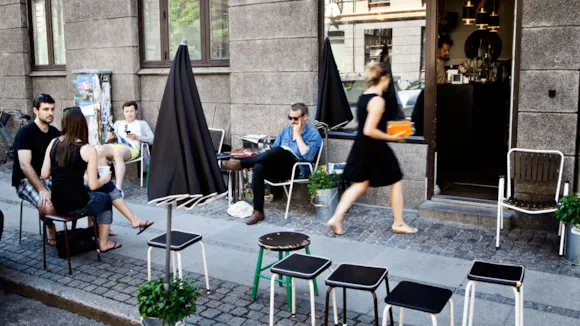
0.28 km
The infamous red light district and former working-class area of Copenhagen, Vesterbro, is actually one of the hippest areas in the Danish capital. As early as back in 2001, Wallpaper magazine proclaimed Vesterbro Copenhagen's hippest quarter, and in 2014 it made no. 4 on Thrillist's top 10 most hipster neighbourhoods on Earth.
The turnaround really began with the transformation of the old cattle market Øksnehallen into a light and stylish exhibition hall. The district is situated within walking distance of Copenhagen city centre, right behind the Central Station. It is one of the most fashionable places in Copenhagen - not just to live - but to shop, eat, drink and have a great night out.
Along Vesterbrogade and Istedgade, where you will find the original red light district on the first stretch from Copenhagen Central Station and up, you will find plenty of bars, restaurants, and designer stores. Are you looking for a fancy dinner or a fun night out go to the Meatpacking District where new restaurants and cool bars crowd the area. The quarter even boasts its own food street, frenchy Værnedamsvej – a gourmet’s paradise with specialist cheese, wine, fish and chocolate shops, as well as cafes and grocers - on the border between Frederiksberg and Vesterbro. Vesterbro is also known as Copenhagen V.

0.28 km
Axel Towers is designed by the talented Lene Tranberg from the award winning Danish architect firm Lundgaard & Tranberg Arkitekter.
The architect firm is also known for the Tietgen Dormitory, SEB Headquarters, The Royal Playhouse and Ofelia Plads.
Axel Towers is the vision of new Danish architecture, gathering people who live and work in the city by featuring both offices, shops, eateries, public gardens and restaurants. The Michelin-starred restaurant AOC opened their 'sibling restaurant', TRIO, on the 9th and 10th floor in autumn 2017.

0.32 km
At the southern end of Skt Jørgens Sø lake, you’ll find a striking modern building offering you a ticket into space. A visit to Copenhagen’s planetarium will put stars in the eyes of the whole family.
Designed by MAA Knud Munk and opened in 1989, the planetarium is named after the Danish astronomer Tycho Brahe, and aims to educate and entertain the whole family through exhibitions and 3D and IMAX films.
Immerse yourself in the starry sky, watch movies in the large Dome and explore the exhibitions. The Dome is the heart of the Planetarium and is the largest in Northern Europe, with a big screen offering you a unique experience, that makes you feel like you are part of the movie. From films about volcanoes and astronauts to space exploration and animations suitable for younger children, there is a wide variety of programming. Check the website beforehand to find out the current program and show times.
No matter what film you choose, it always starts with a journey into space and a presentation of the current starry sky.
Most movies and shows will be narrated in Danish. However, if you would like to hear the English narration, headphones are available at the entrance.
A ticket gives access to all exhibitions and one film. During school holidays and weekends, you can also experience shows and stories about the universe, with free guided tours in the exhibition area.
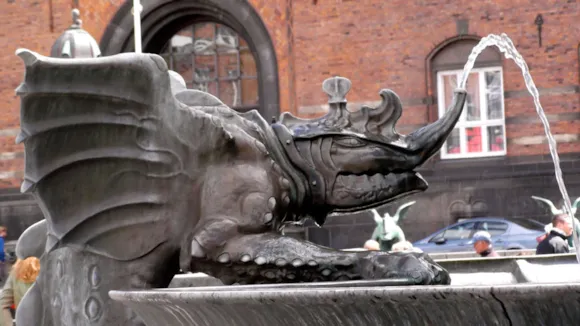
0.44 km
The Dragon Fountain at Copenhagen City Hall Square was made from a model in 1889 and was originally intended for Amagertorv but lost to the The Stork Fountain.
In 1904 a bronze basin was erected with decoration inspired by ancient Greek ornamentation in Copenhagen. On the edge of the basin were placed three dragons, all spouting water and rather larger than sketched in the 1889 project.
In 1908 the fountain was surrounded by a low, outer basin with a granite edge after a design by Skovgaard and Bindesbøll, but not until 1923 was the Dragon Fountain completely finished with a bull battling with a dragon.
Large and small dragons
So as not to squeeze the group at the centre, the three dragons on the edge of the basin were made rather smaller and thus in keeping with the original project. The large dragons are today on the balustrade in front of the Town Hall.
At the same time, the outer basin’s granite edge was decorated with six bronze baskets of fruit placed on every other one of the twelve stone consoles. This new version of the spring was inaugurated on 4 June 1923.
Moved and seperated
Vestre Boulevard was widened and altered in 1954 and at the same time had its name changed to HC Andersens Boulevard.
The entire fountain was moved 25 metres into the square, and the outer granite basin with the bronze baskets was removed. This was set up in Brønshøj Torv in 1973, but removed again in 2001.

0.45 km
One of Copenhagen’s main squares, City Hall Square or Rådhuspladsen is in front of the City Hall. It marks the start of the shopping street Strøget and is a key location for events and demonstrations.
It's an important public gathering space for the city – people gather here for demonstrations, to pay tribute to returning sports heroes, for big concerts, and for outdoor exhibitions and events including Copenhagen Pride. It's also the site of a hot dog stand, and occasionally plays host to flea markets.
The square is on the site of the city's former hay market and has been redesigned many times over the years, the most recent being in 1995-6.
Among the sculptures in the square are The Dragon Fountain, showing a fight between a bull and a dragon, and a statue of Hans Christian Andersen. If you look to the Richs Building from the square, you can also see The Weather Girl, a gilded sculpture of a girl with a bike that tells the weather. On rainy days, it rotates to show her walking her dog with an umbrella.
There is a bus hub on the northern side of the square, along with a metro station, making it a key public transport hub.
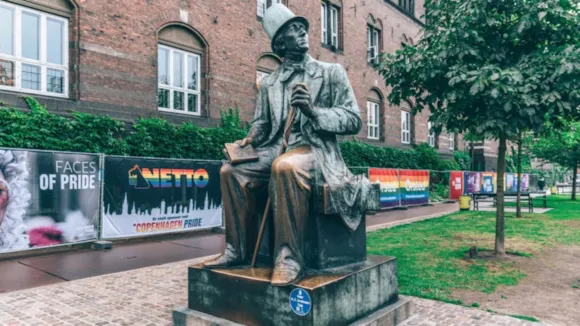
0.46 km
Author Hans Christian Andersen is a very important part of Danish culture, and his fairytales are known worldwide.
Around Copenhagen, you will find many statues of the world-famous author and poets.
At Copenhagen City Hall Square, facing H.C. Andersens Boulevard features a statue of Hans Christian Andersen who sits with a book.
The bronze statue is made of Henry Luckow-Nielsen and was erected in 1965.

0.47 km
In the heart of Copenhagen, you will find Copenhagen City Hall. Copenhagen City Hall was built in 1892-1905 and was designed by architect Martin Nyrop. Martin Nyrop was inspired by the town halls of Italy, and the building is today considered as a classic of the National Romantic style. The National Romantic features shine through throughout the building - from the richly decorated exterior to the detailed interior with hidden gems hidden in everything from murals to stair railings.
Today, the Town Hall is used for Civic Council meetings, weddings and national celebrations.
Guided tours
The City Hall can be explored on your own, but if you want the full experience of Copenhagen City Hall and it's secrets, you can join a guided tour Monday-Friday at 13.00 and Saturday at 10.00. The tour is about 50 minutes and the competent guide takes you around the City Hall, as well as up the City Hall Tower, which with it's 105.6 metres is one of the tallest buildings in Copenhagen. Tickets can be booked here.
If you only want to visit the tower, you can join the tour Monday-Friday at 11.00 and 14.00 or Saturday at 12.00.
Note: There are about 300 steps to the balcony of the Town Hall Tower and no elevator.
City Hall Library
Need a quiet place to study for exams? Although the City Hall Library no longer functions as a library, the beautiful hall now provides the perfect quiet reading room, creating just the right study atmosphere
The City Hall Library is free and open from Monday till Friday from 09.00-16.00.
Wedding at the town hall
If you dream of getting married in a beautiful and historic setting, you can get married in the beautiful Wedding Hall at Copenhagen City Hall. Read more about weddings at City Hall here.
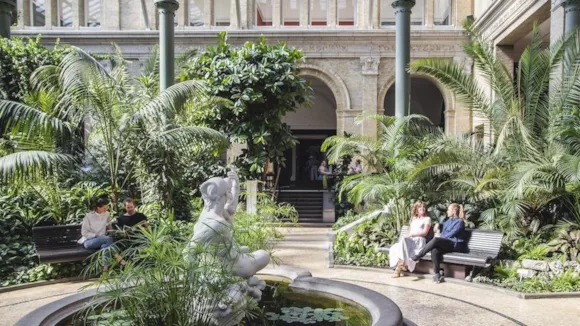
0.59 km
Ny Carlsberg Glyptotek displays ancient and modern art in truly unique surroundings. Founded in 1897 by brewer Carl Jacobsen, the gallery is renowned for its marble sculptures and winter garden.
Step inside and discover a beautiful building with high ceilings and a showstopping centrepiece winter garden full of palm trees surrounding a fountain and pond.
The Collections
The gallery is divided into ancient and modern collections. The Department of Antiquities houses excellent collections of Egyptian, Greek, Etruscan and Roman art, providing a delightful journey through 3500 years of art and history. Stroll the hallways lined with marble statues, and you can imagine yourself in Ancient Greece, Egypt or Rome.
The Modern Department focuses on Danish painting and sculpture of the 19th and 20th centuries and French art of the same period. Enjoy paintings from Denmark’s awe-inspiring Golden Age, and experience French Impressionism as well as more than 40 works by Gauguin. It is also possible to see the complete series of Degas’ bronzes and 35 sculptures by Rodin.
Special exhibitions
The Ny Carlsberg Glyptotek often holds special exhibitions which are presented as an integrated part of the museum experience. These exhibitions may require that certain works in the permanent collection, ordinarily accessible to the public, will not be on display. We recommend checking the website for information on exhibitions and current events before your visit.
In the beautiful and spacious Winter Garden, you can take a breather and refresh yourself at Café Picnic where you can enjoy a piece of cake, a light lunch, or maybe just a coffee in the peaceful surroundings. The gallery also has a small bookshop and souvenir shop.

0.73 km
Step into Denmark's most significant treasure trove of stories
In the exhibition Prehistoric Denmark, you can see iconic finds such as the Sun Chariot, the Egtved Girl, and the Gundestrup Cauldron. You can also meet the Huldremose Woman, whose life and death continue to inspire wonder. Among Viking swords, silver treasures and divination amulets, you will gain insight into a time when Denmark was a maritime superpower.
Modern and engaging exhibitions
In the latest exhibitions, such as "The Viking Sorceress," you will gain a rare insight into the beliefs, destiny, and worldview of the Vikings, as told through the völva – a seeress and cultural icon of the Viking Age.
And in KA-CHING!, we ask how money has shaped our lives over thousands of years. You can even play along: maybe you’ll win a million and a trip in the money pit.
From grandeur to play at child height
At the National Museum, you can immerse yourself in the historical halls from the 1700s — the Prince’s Palace, where stucco, panels and chandeliers bear witness to grandeur and elegance. For families with children, the Children’s Museum is the highlight, where you can sail in a Viking ship, cook in a medieval kitchen and experience school life in the 1950s. The best thing about it all is that you can touch, play and laugh as much as you want.
See the most important things – or explore at your own pace
Take a trip through history at your own pace. You can pick up the museum’s free audio guide and let the objects tell their stories as you move around. You can also choose to take a private tour – for example, of the Klunkehjem apartment, a unique and well-preserved 19th-century gem.
Taste history – or bring it home
In the museum restaurant, you can enjoy classic Danish dishes, coffee and cake. Also, stop by the museum shop, where you can buy designer crafts, history-themed gifts and delicious delicacies ranging from mead to museum beer.
A visit to the National Museum is an experience that awakens all the senses!

1.73 km
Back in the days, Nyhavn was a bustling port where sailors from all over the world would visit the pubs, alehouses and ladies of pleasure. Today the beautiful houses are one of Copenhagen’s most iconic and atmospheric spots. With its brightly painted 17th-century houses, lively cafés, canal tours, and rich history, Nyhavn is where the city’s maritime past meets its laid-back present. As you walk beside the canal during the summer season, you’re greeted by the sounds of jazz and the sights of pavement cafés where people enjoy life and great traditional Danish food like smørrebrød (open-faced sandwiches). The atmosphere remains lively throughout Christmas. At this time of year, the air in Nyhavn is scented with gløgg as the annual Christmas market fills the cobbled street with decorated stalls and twinkling lights.
What is Nyhavn known for?
Nyhavn is famous for its colourful historic houses, canal tours, vibrant dining scene, and links to Hans Christian Andersen.
Who lived in Nyhavn?
The Danish fairytale writer Hans Christian Andersen lived in three different Nyhavn houses (No. 20, 67, and 18), where he wrote classics like The Tinderbox and The Princess and the Pea.
Can you take a canal tour from Nyhavn?
Yes. Several companies offer canal tours that depart from Nyhavn, giving you access to Copenhagen’s waterways and landmarks.
Is Nyhavn only for tourists?
Not at all. Locals enjoy it too – especially on warm days with a cold beer by the harbour.
What happens in Nyhavn at Christmas?
During December, Nyhavn hosts a Christmas market with twinkling lights, stalls, gløgg (mulled wine), æbleskiver (pancake puffs), and other Danish holiday dishes.
From traditional Danish dishes to modern Nordic plates, Nyhavn is a culinary hub:
Nyhavn is more than a postcard view – it is a living piece of Copenhagen’s history. Once alive with sailors and taverns, today it is a place to stroll, enjoy food and drinks by the water, listen to jazz, or embark on a canal tour. Whether in summer sunshine or under Christmas lights, Nyhavn offers a vibrant glimpse of Copenhagen at its best.